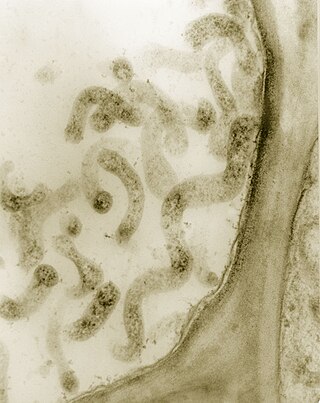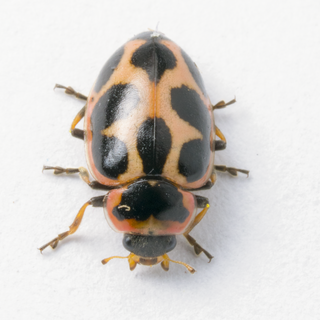Michael Eugene Nicolas Majerus was a British geneticist and professor of evolution at the University of Cambridge. He was also a teaching fellow at Clare College, Cambridge. He was an enthusiast in Darwin's theory of evolution by natural selection and became a world authority in his field of insect evolutionary biology. He was widely noted for his work on moths and ladybirds and as an advocate of the science of evolution. He was also an enthusiastic educator and the author of several books on insects, evolution and sexual reproduction. He is best remembered as an ardent supporter and champion of experiments on peppered moth evolution.

Harmonia axyridis is a large lady beetle or ladybug species that is most commonly known as the harlequin, Asian, or multicoloured Asian lady beetle. This is one of the most variable species in the world, with an exceptionally wide range of colour forms. It is native to eastern Asia, but has been artificially introduced to North America and Europe to control aphids and scale insects. It is now common, well known, and spreading in those regions, and has also established in Africa and widely across South America. This species is conspicuous in North America, where it may locally be known as the Halloween beetle, as it often invades homes during October to overwinter.

Melanism is the congenital excess of melanin in an organism resulting in dark pigment.

Spiroplasma is a genus of Mollicutes, a group of small bacteria without cell walls. Spiroplasma shares the simple metabolism, parasitic lifestyle, fried-egg colony morphology and small genome of other Mollicutes, but has a distinctive helical morphology, unlike Mycoplasma. It has a spiral shape and moves in a corkscrew motion. Many Spiroplasma are found either in the gut or haemolymph of insects where they can act to manipulate host reproduction, or defend the host as endosymbionts. Spiroplasma are also disease-causing agents in the phloem of plants. Spiroplasmas are fastidious organisms, which require a rich culture medium. Typically they grow well at 30 °C, but not at 37 °C. A few species, notably Spiroplasma mirum, grow well at 37 °C, and cause cataracts and neurological damage in suckling mice. The best studied species of spiroplasmas are Spiroplasma poulsonii, a reproductive manipulator and defensive insect symbiont, Spiroplasma citri, the causative agent of citrus stubborn disease, and Spiroplasma kunkelii, the causative agent of corn stunt disease.

Adalia bipunctata, the two-spot ladybird, two-spotted ladybug or two-spotted lady beetle, is a carnivorous beetle of the family Coccinellidae that is found throughout the holarctic region. It is very common in western and central Europe. It is also native to North America but it has heavily declined in many states and provinces. It is commonly introduced and imported as a biological control agent.

Industrial melanism is an evolutionary effect prominent in several arthropods, where dark pigmentation (melanism) has evolved in an environment affected by industrial pollution, including sulphur dioxide gas and dark soot deposits. Sulphur dioxide kills lichens, leaving tree bark bare where in clean areas it is boldly patterned, while soot darkens bark and other surfaces. Darker pigmented individuals have a higher fitness in those areas as their camouflage matches the polluted background better; they are thus favoured by natural selection. This change, extensively studied by Bernard Kettlewell (1907–1979), is a popular teaching example in Darwinian evolution, providing evidence for natural selection. Kettlewell's results have been challenged by zoologists, creationists and the journalist Judith Hooper, but later researchers have upheld Kettlewell's findings.

Coccinellidae is a widespread family of small beetles. They are commonly known as ladybugs in North America and ladybirds in the United Kingdom; "lady" refers to mother Mary. Entomologists use the names ladybird beetles or lady beetles to avoid confusion with true bugs. The more than 6,000 described species have a global distribution and are found in a variety of habitats. They are oval beetles with a domed back and flat underside. They are sexually dimorphic; adult females are larger than males. Many of the species have conspicuous aposematic (warning) colours and patterns, such as red with black spots, that warn potential predators that they taste bad.

Coccinella undecimpunctata, the eleven-spot ladybird or eleven-spotted lady beetle, it is native to central Asia, though commonly found in Europe, and formerly North America as its populations are decreasing. It is of the family Coccinellidae, commonly referred to as ladybugs or lady beetles.

Adalia decempunctata, the ten-spotted ladybird or ten-spotted lady beetle, is a carnivorous beetle of the family Coccinellidae.
In the 10th edition of Systema Naturae, Carl Linnaeus classified the arthropods, including insects, arachnids and crustaceans, among his class "Insecta". Insects with hardened wing covers were brought together under the name Coleoptera.

Coleomegilla maculata, commonly known as the spotted lady beetle, pink spotted lady beetle or twelve-spotted lady beetle, is a large coccinellid beetle native to North America. The adults and larvae feed primarily on aphids and the species has been used as a biological control agent. Based on name connotation and to avoid confusion with other species also called "spotted ladybeetle", spotted pink ladybeetle is probably the most appropriate common name for this species.

Diplacodes bipunctata is a species of dragonfly in the family Libellulidae, known as the wandering percher or red percher dragonfly.

Coccinellinae is a subfamily of lady beetles in the family Coccinellidae. There are at least 20 genera and 90 described species in Coccinellinae.

Macromonasbipunctata is a Gram-negative, colorless, and heterotrophic sulfur bacterium of the genus Macromonas. It is commonly found in sewage aeration tanks and caves where moonmilk has formed. In the 1920s, researcher Gicklhorn first discovered this organism under the name Pseudomonasbipunctata. After further study and culturing by Utermöhl and Koppe, in 1923, it was later renamed Macromonasbipunctata. This organism is thought to be non-pathogenic species. In fact, the moonmilk produced was referenced as a remedy for infections in the Middle Ages.
Bucolus fourneti is a native Australian, small, hairy coccinellid beetle approximately 2.1-4.5 mm in diameter. It was described by Étienne Mulsant in 1850
Allenius is a genus of lady beetles in the family Coccinellidae, containing a single species, Allenius iviei.

Naemia seriata, commonly known as the seaside lady beetle, is a large coccinellid beetle native to North America, and the only species in the genus Naemia. It is found in coastal areas such as beaches, salt marshes, and bay islands on the Atlantic and Pacific coast. This beetle is light brown, yellow, orange, or red in color, with large black spots, often connected along the sides. The pronotum usually has one large central black spot, which is occasionally split into two spots. The body of this species is elongately oval in shape, and between 4 and 6.7mm in length. The two subspecies can be distinguished by markings on the head, with the head of N. seriata seriata being black, while the head of N. seriata litigiosa has a pale triangular marking. Naemia seriata seriata is primarily distributed across Eastern North America, while N. seriata litigiosa is restricted to the American Southwest.

Cantharis rustica, the rustic sailor beetle, is a species of soldier beetle found in Europe east to central Russia.














